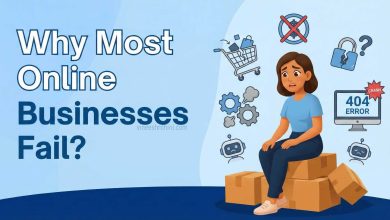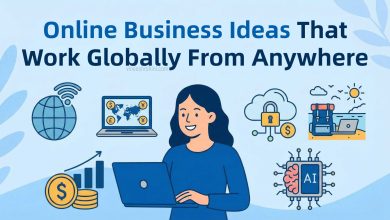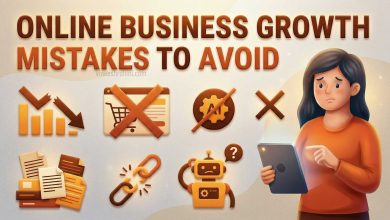The 5 Biggest Challenges Of Moving Your Business Online
Moving your business online can be a daunting task, but it’s necessary for businesses to remain competitive in today’s digital age. However, this move comes with its own set of challenges that business owners must overcome. In this essay, we will discuss the five biggest challenges of moving your business online and offer tips on how to overcome them.
- Building Your Brand Presence Online
Building your brand presence online is the first and perhaps most critical challenge of moving your business online. Establishing a strong brand identity requires consistency, creativity, and a deep understanding of your target audience.
To build your brand presence online, start by creating a strong visual identity, including your logo, color scheme, and typography. Consistency is key when it comes to branding, so make sure your visual identity is consistent across all your online channels.
Another important aspect of building your brand presence online is creating a strong voice and tone that resonates with your target audience. This involves understanding their needs, wants, and pain points, and crafting messaging that speaks to them.
Social media platforms are a great way to build your brand presence online. Use platforms like Facebook, Instagram, and Twitter to engage with your audience and promote your products or services. Don’t forget to monitor your social media accounts regularly and respond promptly to comments and messages.
- Learning How To Use Digital Tools
The second challenge of moving your business online is learning how to use digital tools effectively. These tools include everything from social media platforms to email marketing software to website builders.
To overcome this challenge, start by identifying which digital tools are essential for your business. For example, if you’re an e-commerce business, you’ll need an online store platform like Shopify or WooCommerce. If you’re a service-based business, you’ll need a project management tool like Trello or Asana.
Once you’ve identified the digital tools you need, invest time and resources into learning how to use them effectively. Many digital tools offer free or low-cost training resources, including online courses, webinars, and tutorials.
Consider hiring a digital marketing agency or consultant to help you navigate the digital landscape. These experts can provide valuable insights and guidance on which tools to use and how to use them effectively.
- Creating Quality Content
Creating quality content is another critical challenge of moving your business online. Your online content should be informative, engaging, and optimized for search engines.
To create quality content, start by developing a content strategy that aligns with your business goals and target audience. This strategy should include a content calendar that outlines the topics, formats, and publishing schedule for your content.
When creating content, focus on providing value to your audience. This means answering their questions, providing helpful tips and advice, and showcasing your expertise in your industry.
Optimize your content for search engines by incorporating keywords and phrases that your target audience is searching for. Use tools like Google Keyword Planner to identify these keywords and phrases and incorporate them naturally into your content.
- Making Your Website Mobile-Friendly
Making your website mobile-friendly is another significant challenge of moving your business online. With more and more people accessing the internet on their mobile devices, it’s essential to ensure that your website is optimized for mobile viewing.
To make your website mobile-friendly, start by choosing a responsive website design. Responsive design adjusts your website’s layout and content to fit the screen size of the device it’s being viewed on.
Optimize your website’s loading speed by compressing images, reducing the number of plugins you use, and minimizing the use of large files.
Ensure that your website is easy to navigate on a mobile device by simplifying your menu and making your calls to action (CTAs) prominent.
- Crafting An Effective SEO Strategy
The final challenge of moving your business online is crafting an effective SEO strategy. SEO (Search Engine Optimization)
The final challenge of moving your business online is crafting an effective SEO strategy. SEO (Search Engine Optimization) is the practice of improving the visibility and ranking of your website in search engine results pages (SERPs).
To craft an effective SEO strategy, start by conducting keyword research. Identify the keywords and phrases that your target audience is searching for and incorporate them into your website’s content.
Optimize your website’s on-page elements, including title tags, meta descriptions, headers, and images. Ensure that these elements accurately reflect the content on each page and include relevant keywords.
Build high-quality backlinks to your website by creating valuable content that other websites will want to link to. This can include blog posts, infographics, videos, and other types of content that provide value to your audience.
Regularly monitor your website’s analytics to track your SEO progress. Use tools like Google Analytics to track your website’s traffic, engagement, and conversion rates. Use this data to make informed decisions about your SEO strategy and adjust your approach as needed.
Conclusion
Moving your business online comes with its own set of challenges, but it’s essential for businesses to remain competitive in today’s digital age. By building your brand presence online, learning how to use digital tools effectively, creating quality content, making your website mobile-friendly, and crafting an effective SEO strategy, you can overcome these challenges and establish a strong online presence for your business.
Remember that moving your business online is not a one-time process but an ongoing effort. Continuously monitor your online presence, analyze your results, and adjust your strategy accordingly to ensure that your business remains relevant and successful in the ever-evolving digital landscape.



